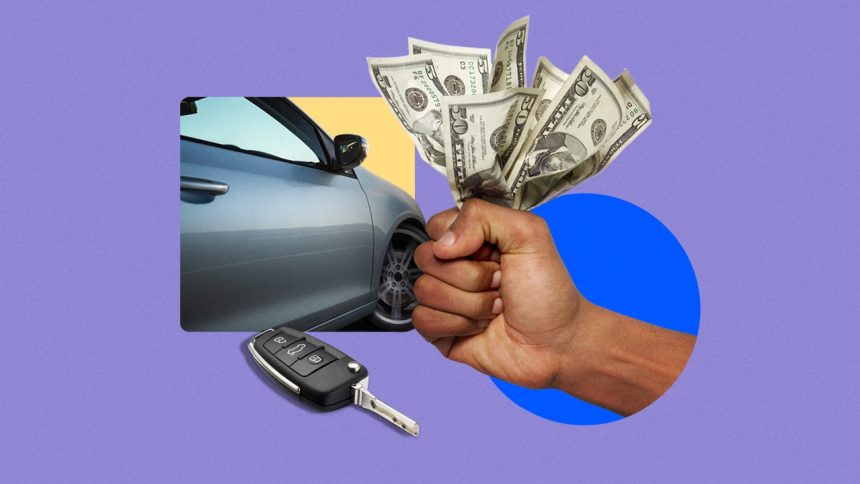Images by Getty Images; Illustration by Issiah Davis/Bankrate
Key takeaways
- Cash-out auto refinance lets you take equity from your car loan by swapping it out with a larger one, typically with different terms.
- The amount you can access depends on your vehicle’s value, credit history and the lender.
- Be sure to consider the risk of going upside down on your loan, which could make it challenging to sell or trade your vehicle in the near future.
- Weigh the benefits and drawbacks of this strategy to get fast cash to determine if it makes sense financial sense for you.
Cash-out auto loan refinancing, also known as cash-back refinancing, is like traditional refinancing in the sense that you apply to receive new, more favorable terms to replace your current loan. But, along with that, you will also receive a lump sum of cash as part of the refinance. The amount you receive depends on the equity present in your vehicle.
Car owners may consider this type of refinance if they are in urgent need of money for an emergency, but this choice does come with the cost of increasing the borrower’s debt.
What is cash-out auto refinancing?
A cash-out auto loan refinance allows you to swap out your current loan for a new one for a higher amount and access the difference in cash. The variance between the two loans is the amount of equity you have in your vehicle or the amount you own outright. This type of loan is typically used by those who carry an auto loan but currently have equity in their vehicle and need extra money.
Not all lenders offer this service, and it can be a risky move. The process increases the possibility of becoming upside-down on your loan, making your car more challenging to sell until you’re no longer upside-down.
Being upside down means your outstanding loan balance is more than the vehicle is worth. In other words, if you owe $4,000 on a car loan, but the car’s value is only $2,000, you are upside-down on the loan. If you have no plans to sell the car, being upside down is not necessarily a problem. Just continue to make payments and pay off the loan.
If, on the other hand, you hope to trade in your vehicle, being upside-down can be a challenge. You’ll need to pay off the negative equity yourself.
How much can I borrow through a cash-out loan?
The amount that you can borrow, and thus the amount of cash that you will receive, is dependent on a few factors.
- The lender: Not all lenders offer a cash-out option due to the increased risk of default posed by you increasing the amount you owe.
- Vehicle value: The value of your vehicle determines the amount of money your lender will give you.
- Your credit history: As with most financial circumstances, your credit score and history serve as the core measure for whether your loan will be approved. The better your credit is, the more favorable terms you will receive.
When is cash-out auto refinancing a good idea?
Cash-out auto refinancing is a good idea if you experienced a financial emergency and need money or if you intend to use the cash to pay off debt with higher interest, like credit card debt.
Determining whether a cash-out auto refinance is right for you takes reflection on your spending habits. Because this choice means borrowing more money than you already owe, you are creating more debt. If you are currently struggling to make your monthly payments, this could worsen your financial situation.
The two primary benefits of cash-out refinance are:
- Improved loan terms: Just as with traditional refinancing, you will ideally receive more favorable interest rates through this process. But you’ll increase your loan principal, and if you want to lower your monthly payment, you’ll likely need to extend the loan term. That means you’ll spend more on interest over the loan’s lifetime.
- Additional cash: You will receive money from a cash-back refinance, which can be especially helpful if you need additional cash for an emergency. However, this is a short-term solution that could lead to higher interest rates.
Cash-out refinancing risks
As with any auto loan product, cash-back auto refinance is not without risk. Consider these potential drawbacks before proceeding with the application process.
- Going upside down on loan: You are more likely to become upside down or underwater on your loan. As the car’s value depreciates, your loan-to-value ratio increases the likelihood of being underwater — owing more than the vehicle is worth. Having negative equity is also a major risk if you get in an accident and your insurance does not cover the full cost.
- Incurring more debt: Borrowing more than you owe stacks even more debt on your plate.
- Risk of repossession: If you struggle to keep up with your monthly payments, extending your loan may not be enough to fix deeper financial problems. This could mean your vehicle is taken if you fail to pay.
- Few lenders to choose from: Not all lenders offer this type of financing, so you may be stuck with very few options to choose from when shopping around.
How to apply for cash-out auto refinancing
The process of applying for cash-out auto refinance is similar to what you would do for a traditional refinance. It simply requires paperwork and research. After determining how much your vehicle is currently worth — through outlets such as Kelley Blue Book — you will have an idea of the amount of equity on the vehicle. This number will inform how much cash you can potentially receive.
To find the amount of equity in your vehicle, you must calculate the current value of your car minus the balance you have left to pay. If you want to avoid mental math, an equity calculator can handle the calculations for you.
Finding a lender that offers cash-back auto refinancing will take a bit more work. Not all lenders offer this service. After researching different lenders, compare the terms and determine which option is best for you. Pay special attention to the amount of money you will receive. Following the application and loan approval, you will walk away with new loan terms and extra money.
Bankrate tip
The bottom line
Cash-out refinancing can be a good option if you’re looking to score more favorable terms on your auto loan or have an urgent need for cash. The first step when considering this type of refinance is to research the current value of your car. This will help determine how much money a lender may be willing to give you.
But remember, there are risks involved in a cash-out refinance. You incur more debt by refinancing the auto loan for more than what’s currently owed, and you also risk becoming upside-down on the loan.
Read the full article here














